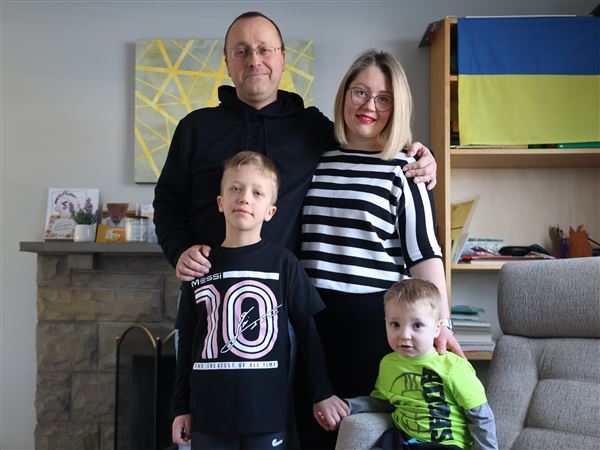Melissa Ludwig was on top of the world, at least on paper.
She married the “right” guy, the “great” guy. She was the mom of a brand-new baby girl. Fortunate enough to access maternity leave, she had nothing but time to savor every whiff of her baby’s head and marvel at the tininess of each toe.
But as she slid forward and back in the brand new glider placed in her baby’s freshly decorated nursery, her mind rested in none of that supposed bliss.
Ludwig had battled her own mind for long enough to know depression and more were taking hold of her thoughts and, despite the “great” guy, her instincts led her elsewhere: “You need to get out of this house, and get some friends.”
In her pocket of the universe, that thought was revolutionary. It was also evolutionary.
Stress responses are often assumed to be “fight-or-flight” reactions, periods where all of the survival mechanisms in our bodies mount simultaneously and inspire us to fight a threat or run away from it.
But researchers such as Laura Cousino Klein, a Pennsylvania State University professor of biobehavioral health, believe women can respond to stress uniquely and exactly as Ludwig did.
Cousino Klein — and a group of researchers who published this theory 23 years ago in the journal Psychological Review — believes women may have evolved to respond to stress via “tend-and-befriend,” which serves to protect offspring and promote feelings of security through the creation and maintenance of social networks.
Often those connections would have been with women.
“Females have fight-or-flight and tend-and-befriend, and the same is true for males. It’s just that males are pulled more to fight-or-flight because of the hormone vasopressin,” Cousino Klein said. “But fight-or-flight isn’t a social response at all, it’s ‘I need to fix this. I need to fight this,’ whereas tend-and-befriend is about gathering your tribe of women to commiserate, talk and experience that stressor together.”
Here’s the logic. Especially in early societies, women were the child-rearers. If a fire broke out in the settlement, traditional notions of fight-or-flight would have minimal use if mothers — whose mates were likely busy with other tasks — were singularly responsible for gathering all of their children and belongings before seeking safety, making social networks (“befriend”) vital to survival.
Or if a predator was lurking, fighting or fleeing could draw attention and spell certain death for a mother or her offspring. But if her body dumped large amounts calming chemicals into her bloodstream in the face of stress (oxytocin and natural opioid mechanisms, Cousino Klein says), her urge would be to settle her children, hold them close and quiet — “tend” to them — potentially allowing that threat to walk right on by.
These behaviors leading to survivorship — and the chance for those children to also have children — is how “evolution” happens.
Female-female friendships isn’t a common area of study, which helps give Cousino Klein’s work even more staying power. But it, too, seems to evolve: “Every year, I always think there are more and more implications of this work,” she said.
Modern American women may not face a wolf attack very often, but they combat their own stressors with responses that, many times, harken back to tend-and-befriend.
Ludwig’s instinct to reach for female friends after having a baby is hardwired, as group living in hunter-gatherer societies would have automated support for postpartum women.
Though unproven, it’s been suggested by a few scholars that postpartum depression may serve the evolutionary purpose of recreating those social networks, as loved ones rally around the struggling mother.
But it’s neither only about having babies nor only about generic support.
Charlotte, the quirky and relatively demure socialite in HBO series “Sex in the City,” homed in on the instinctive nature of many women to seek other women — when kids are tough, when husbands aren’t getting it, and when social media has us questioning everything — when she asked, “Could those friendships be the primary relationships in our lives?”
“I don’t know, but I do know that many women — me included — wouldn’t be functioning as well as they are without those close female friendships,” she answered herself.
“When women connect with each other, there’s a shared understanding of a lot of different pieces of what it means to be women,” said Marissa Barash, a therapist at Allegheny Health Network’s Women’s Behavioral Health clinic.
Ludwig, now 41, of Millvale, found her tribe — exactly when she needed it — through a wellness group. Among those women, she didn’t have to explain why she needed them because they were all drawn by the same innate desire for connection.
“Women want to be validated, and heard, and seen, and empowered,” Ludwig said. “[W]ith my girlfriends, we make space for each other to make the emotions bigger so we can understand them, and hopefully move past them. That’s the biggest thing.”
Abby Mackey: amackey@post-gazette.com and IG @abbymackeywrites
First Published: October 29, 2023, 9:30 a.m.
Updated: October 29, 2023, 3:49 p.m.



















